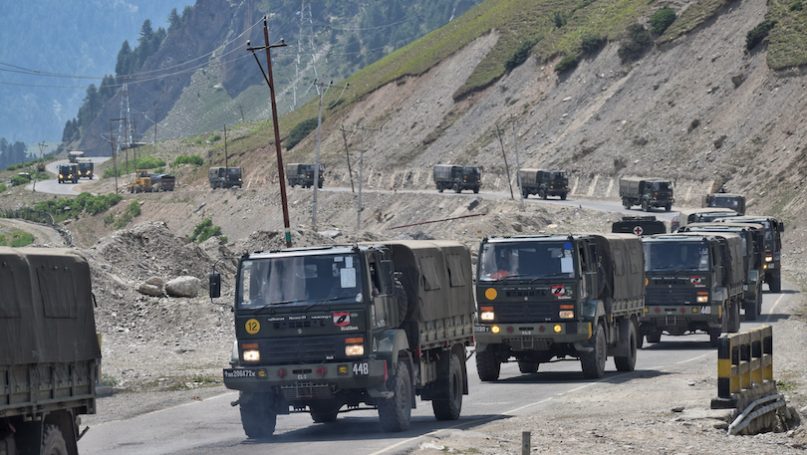
On 1 July 2021, there were reports about the deployment of women soldiers from the Assam Rifles (one of the paramilitary forces) to conduct security operations and assist Indian troops in Kashmir in “maintaining peace in the Valley.” While they were previously engaged in some areas of Kashmir in 2020 to keep a check on “drug smuggling,” they have now been authorised to assist the Indian state with its counter-insurgency (COIN) operations. The Indian Army maintained that the women personnel were a force multiplier and when deployed at checkpoints, they would help “bridge the gap” between the locals and the armed forces. A day later, photographs emerged of women in combat gear with guns in their hands, standing guard, frisking Kashmiri women and other regular deployments.
Elsewhere, women’s “right to fight” and seeking representation and participation in all aspects of civic life (including the military) is debated in terms of parity and if it substantially addresses the question of gender equality. In Kashmir, however, the question needs to be interrogated in the context of the military occupation. Kashmir is the world’s highest militarised zone with 700,000 Indian military personnel stationed to control the disputed territory. Human rights groups have documented widespread forms of human rights violations including killings, torture, sexual violence, enforced disappearances, mass and unmarked graves, mass blinding committed by Indian soldiers with due impunity in Kashmir. In such a scenario, the role that these riflewomen play becomes one of appearance, where the attempt is to legitimise intensive militarisation with a benevolent face that women are stereotypically seen to represent. This gender code and its discursive effects bring to the fore the notion of bridging the gap as one of erasure of violence; a subtle acknowledgement of there being an issue, and yet a forceful integration of a violent military apparatus with an environment that is hostile to it.
When these combat women frisk Kashmiri women, the photographs that emerge speak a story not only of control but also sexualised depictions where these “courageous” women upholding the honour of the nation are presented as inspirations to produce the right kind of female subjectivity for the nation. Their position is constructed in opposition to the otherised – dangerous Kashmiri women radicalised by Muslim Kashmiri men, potential threats to the idea of India and, and therefore, needing to be put in place. This military-sexual complex, then, helps build a narrative of desire in the Indian psyche with regard to recruitment and motivation for women personnel to join the Indian military to protect the security and integrity of the nation.
This also gets framed as gender equality through women’s presence in the institution of the military and is simultaneously seen as transforming the military to be inclusive of caring and nurturing practices in a zone of combat. This shifts the military narrative from one centered on violence to a “softened” one that understands local culture, familial and community ties. It is, therefore, set out to perfect the counter-insurgency doctrine of winning hearts and minds. This dimension of COIN, that is at least superficially less violent and more inclined to community-building and assimilation with a humanitarian touch, is perceived as a feminine aim, but one that can help counter-insurgency goals where understanding the gender dimensions is a crucial component to winning a war.
This can also be thought of in terms of gendered orientalism, that builds on the binaries of irrational and barbaric versus the rational and civilised. The Indian military woman who partakes in a softer version of a masculinised military structure is out to deradicalise, befriend, guide and act saviour of the otherwise oppressed Kashmiri woman. It highlights an apparently benevolent desire where Kashmiri women’s honour is protected by bringing in female personnel to intrude into their personal spaces during Cordon and Search Operations. The very presence of the Indian forces, their intrusive operations, and the violence of colonial encounters is sought to be erased through attempts at construction of “sisterhood” between these women personnel and Kashmiri women where the latter will find a comparatively “safer” environment to be frisked and searched. It is an enforced sisterhood that uses the category of woman as the common denominator to erase crucial difference and strengthen an institution accused of sexual violence and rejection of accusations of rape as recorded rotten stereo sounds. It is a sisterhood that violently marks its presence and boundaries to repress the goals of liberation in Kashmir.
To think of the woman soldier stationed at checkpoints in Kashmir as gender liberation condones the ways in which frisking and searching as an asymmetrical intimate encounter is performed in an embodied way to imprint power and dehumanise the Kashmiri body. It seeks to make invisible the violence that is central to the Indian State’s presence in and control over Kashmir. In such a context, liberation is to challenge this sisterhood of erasure, to call for and fight towards the dismantling of such systems and structures of violence and repression.
Further Reading on E-International Relations
- Opinion – Gendered Digital Repression in Myanmar’s Online Dissent
- Opinion – Speaking Truth to Power in Kashmir
- Spectacular Violence: Pellet Guns and the Sovereign Right to Maim in Kashmir
- Fixing Ruptured Masculinities: Reflections from Kashmir
- Gendered Memory and Mass Violence: Rwanda, Bosnia, and the Holocaust
- The Case of UN Involvement in Jammu and Kashmir